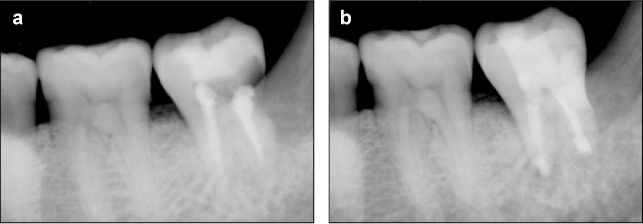J Korean Acad Conserv Dent.
2011 Jan;36(1):12-18. 10.5395/JKACD.2011.36.1.12.
Short-term clinical outcome of intentionally replanted posterior molars
- Affiliations
-
- 1Department of Conservative Dentistry, Section of Dentistry Seoul National University Bundang Hospital, Seongnam, Korea. yhchoi@snubh.org
- KMID: 1446079
- DOI: http://doi.org/10.5395/JKACD.2011.36.1.12
Abstract
OBJECTIVES
This retrospective study evaluated the therapeutic effects of the intentional replantation (IR) procedure performed on the maxillary and mandibular molars of 35 patients.
MATERIALS AND METHODS
For the subjects, IR was performed due to difficulties in anatomically accessing the lesions and/or close proximity to the thick cortical bone, inferior alveolar nerve, or maxillary sinus, which rendered the ordinary periradicular surgery impossible. The patients' progress was followed for a year and up to 2 years and 4 months. The success of the procedure was evaluated in terms of clinical and radiographic success (%).
RESULTS
The results revealed the following: (a) 1 case (3%) of failed tooth extraction during IR; (b) 2 cases (6%) of extraction due to periodontal diseases and inflammatory root resorption; (c) 3 cases (9%) of normally functioning teeth in the oral cavity with minor mobility and apical root resorption, and; (d) 29 cases (82%) of normally functioning teeth without obvious problems.
CONCLUSIONS
IR was confirmed to be a reliably repeatable, predictable treatment option for those who cannot receive conventional periradicular surgery because of anatomic limitations or patient factors.
MeSH Terms
Figure
Reference
-
1. Grossman LI. Intentional replantation of teeth: a clinical evaluation. J Am Dent Assoc. 1982. 104(5):633–639.
Article2. Dryden JA, Arens DE. Intentional replantation. A viable alternative for selected cases. Dent Clin North Am. 1994. 38(2):325–353.3. Weine FS. The case against intentional replantation. J Am Dent Assoc. 1980. 100(5):664–668.
Article4. Friedman S, Mor C. The success of endodontic therapy-healing and functionality. J Calif Dent Assoc. 2004. 32(6):493–503.5. Jin GC, Kim KD, Roh BD, Lee CY, Lee SJ. Buccal bone plate thickness of the Asian people. J Endod. 2005. 31(6):430–434.
Article6. Cohen S, Hargreaves KM. Pathways of the pulp. 2006. 9th ed. St. Louis, MO.;London: Elsevier Mosby;767.7. Penarrocha M, Garcia B, Marti E, Palop M, von Arx T. Intentional replantation for the management of maxillary sinusitis. Int Endod J. 2007. 40(11):891–899.
Article8. Bender IB, Rossman LE. Intentional replantation of endodontically treated teeth. Oral Surg Oral Med Oral Pathol. 1993. 76(5):623–630.
Article9. Nosonowitz DM, Stanley HR. Intentional replantation to prevent predictable endodontic failures. Oral Surg Oral Med Oral Pathol. 1984. 57(4):423–432.
Article10. Guy SC, Goerig AC. Intentional replantation: technique and rationale. Quintessence Int Dent Dig. 1984. 15(6):595–603.11. Friedman S, Lustmann J, Shaharabany V. Treatment results of apical surgery in premolar and molar teeth. J Endod. 1991. 17(1):30–33.
Article12. Hepworth MJ, Friedman S. Treatment outcome of surgical and non-surgical management of endodontic failures. J Can Dent Assoc. 1997. 63(5):364–371.13. Kingsbury B Jr, Wiesenbaugh J Jr. Intentional replantation of mandibular premolars and molars. The Journal of the American Dental Association. 1971. 83(5):1053.
Article14. Koenig KH, Nguyen NT, Barkhordar RA. Intentional replantation: a report of 192 cases. Gen Dent. 1988. 36(4):327–331.15. Barnett RJ, Burton WE, Nuckles DB. Intentional replantation: report of a successful case. Quintessence Int. 1992. 23(11):755–757.16. Raghoebar GM, Vissink A. Results of intentional replantation of molars. J Oral Maxillofac Surg. 1999. 57(3):240–244.
Article17. Peer M. Intentional replantation - a 'last resort' treatment or a conventional treatment procedure? nine case reports. Dent Traumatol. 2004. 20(1):48–55.
Article18. Lee YM, Park JW, Kim SK. Intentional replantation: An alternative treatment option when root canal treatment failed. 2003. In : Spring Scientific Meeting of Korean Academy of Conservative Dentistry; 286–287.19. Kim WC, Yoo MK, LEE KW. Treatment of congenitally abnormal tooth using intentional replantation. 2004. In : Spring Scientific Meeting of Korean Academy of Conservative Dentistry; 320–321.20. Moon JD, Heo B. Intentional replantation: A case report. 2004. In : Spring Scientific Meeting of Korean Academy of Conservative Dentistry; 322–325.21. Hayashi M, Kinomoto Y, Miura M, Sato I, Takeshige F, Ebisu S. Short-term evaluation of intentional replantation of vertically fractured roots reconstructed with dentin-bonded resin. J Endod. 2002. 28(2):120–124.
Article22. Messkoub M. Intentional replantation: a successful alternative for hopeless teeth. Oral Surg Oral Med Oral Pathol. 1991. 71(6):743–747.
Article23. Andreasen JO, Hjorting-Hansen E. Replantation of teeth. I. Radiographic and clinical study of 110 human teeth replanted after accidental loss. Acta Odontol Scand. 1966. 24(3):263–286.
Article24. Kratchman S. Intentional replantation. Dent Clin North Am. 1997. 41(3):603–617.25. Andreasen J, Hjørting-Hansen E. Replantation of teeth. II. Histological study of 22 replanted anterior teeth in humans. Acta Odontologica Scandinavica. 1966. 24(3):287–306.
Article26. Choi YH, Bae JH, Kim YK. Atraumatic safe extraction for intentional replantation. J Korean Dent Assoc. 2010. 48(7):531–537.
- Full Text Links
- Actions
-
Cited
- CITED
-
- Close
- Share
- Similar articles
-
- A retrospective study of the intentionally replanted mandibular second molars with C-shaped root canal configurations
- Evaluation of the periodontal and pulpal healing of replanted rat molars with doxycycline root conditioning
- The second molars in orthodontics
- Prognosis and Prognostic Factors of Caudate Hemorrhage
- Type I Chiari Malformation Without Concomitant Bony Instability: Assessment of Different Surgical Procedures and Outcomes in 73 Patients




